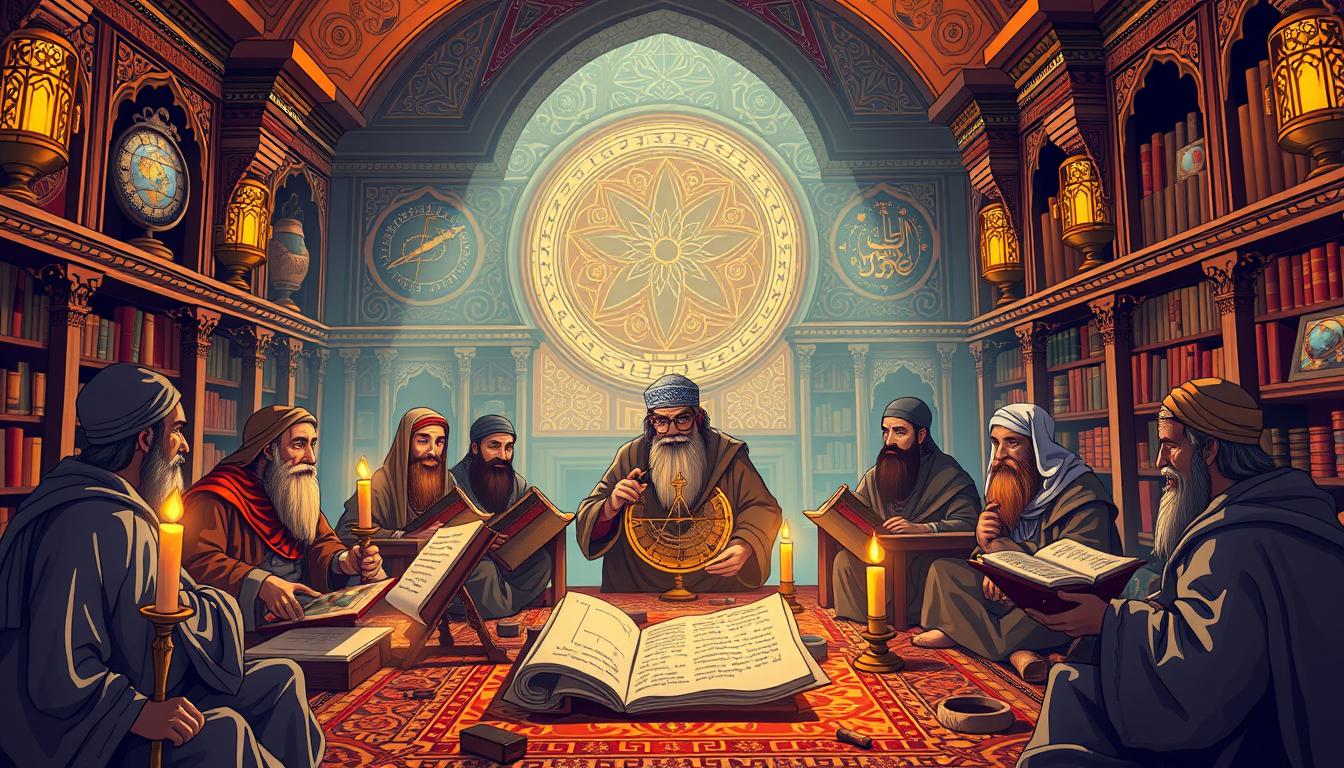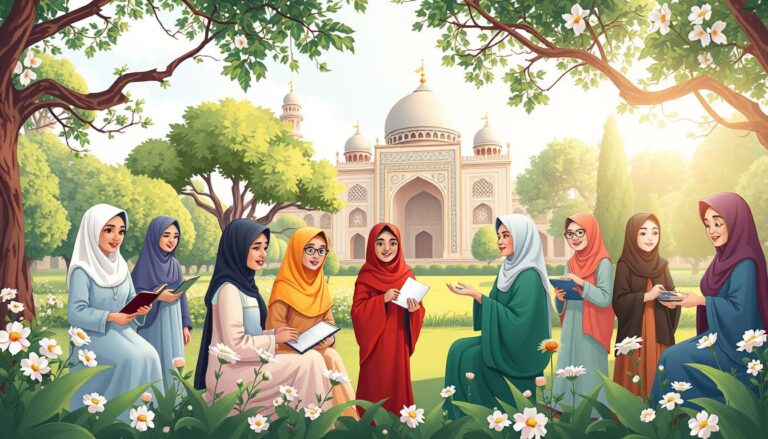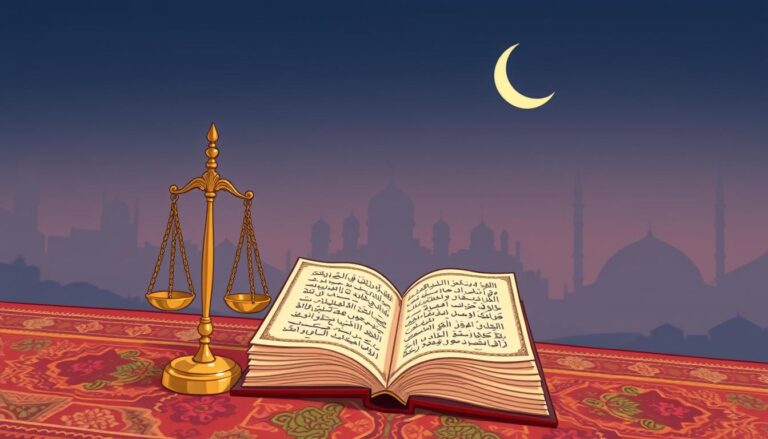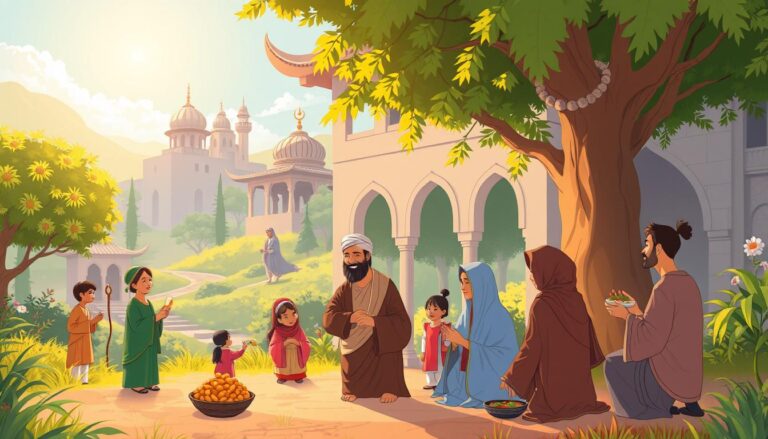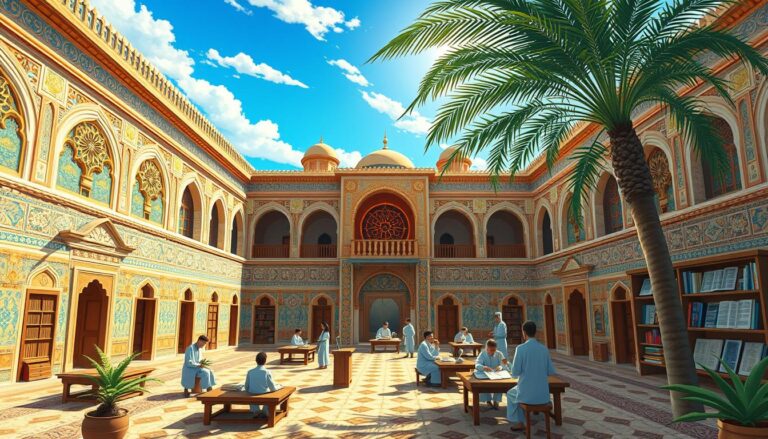The Islamic Golden Age of Science and Innovation
Did you know that modern science’s roots go back to a time when Europe was in the Dark Ages? The Islamic Golden Age, from the 8th to the 14th century, was a time of great intellectual growth. Muslim scholars made discoveries that still shape our world today.
In cities like Baghdad, Cairo, and Córdoba, a spirit of curiosity and innovation thrived. The House of Wisdom in Baghdad, started in the 9th century, was a center of learning. Scholars from all over came to translate and expand ancient knowledge.
From Muhammad ibn Musa al-Khwarizmi’s creation of algebra to Ibn al-Haytham’s work in optics, Muslim scholars expanded human knowledge. Their work in astronomy, medicine, and philosophy laid the foundation for modern science.
Key Takeaways
- The Islamic Golden Age spanned from the 8th to 14th century
- Baghdad’s House of Wisdom was a major center for learning and translation
- Algebra and trigonometry saw significant advancements during this period
- Ibn al-Haytham made crucial contributions to the field of optics
- Medical knowledge expanded greatly, influencing European medicine for centuries
- The era was marked by intellectual curiosity and cross-cultural collaboration
The Rise of Islamic Civilization
The Islamic Golden Age lasted from the 8th to the 13th century. It was a time of great growth and new ideas. This era saw the start of a powerful civilization that changed the world’s thinking.
The Establishment of the First Islamic State
In 622 CE, the first Islamic state was formed. It was the start of a vast empire. The caliphate system of government was created, uniting many regions under Islamic rule.
This system was key for the cultural and scientific progress that came next.
The Expansion of the Islamic Empire
The Islamic empire grew quickly. In just a century, it reached from Portugal to Central Asia. Cities like Baghdad, Cairo, and Córdoba became centers of learning, attracting scholars from everywhere.
Cultural and Intellectual Exchange
The Islamic world became a place where many ideas mixed. Scholars translated works from Greek, Persian, and Indian into Arabic. This exchange led to new discoveries in many fields.
Notable translators like Hunayn ibn Ishaq were paid well, like today’s top athletes.
The introduction of paper from China in the 8th century changed how knowledge was shared. Islamic paper makers used new methods to make big manuscripts. This helped the Islamic Golden Age’s achievements in science and culture.
“The Islamic Golden Age saw the flourishing of science, economic development, and cultural works in the historically Islamic world.”
The impact of this time is still felt today. It shaped modern science, literature, and art. The rise of Islamic civilization inspired a golden age of discovery and innovation that still inspires us.
The Foundations of Islamic Scientific Advancement
The Islamic Golden Age was from the 8th to the 14th century CE. It was a time of great scientific progress. Islamic scholarship and Arabic as a scientific language led the Muslim world to innovate.
Islamic Teaching and Knowledge Pursuit
Islamic teaching was key in seeking knowledge. Scholars saw learning as a religious duty. This led to discoveries in medicine and astronomy.
Translation Movement: Preserving Ancient Wisdom
A big translation movement happened during this time. Scholars translated important works from Greek, Latin, and other languages into Arabic. This kept ancient knowledge alive and shared it with more people. The House of Wisdom in Baghdad was a center for these translations, helping ideas flow between cultures.
Arabic: The Language of Science
As translations grew, Arabic became the language of scholarship. This made knowledge spread across the Islamic world and beyond. Paper production and a book industry grew, helping ideas spread far and wide.
- Arabic translations preserved ancient mathematical, medical, and astronomical texts
- The first observatory in Baghdad was built in the ninth century
- Portable astronomical tools like the astrolabe originated in the Islamic world
These foundations of Islamic scientific advancement paved the way for groundbreaking discoveries. They shaped human knowledge for centuries.
The Islamic Golden Age of Science and Innovation
The Islamic Golden Age lasted from the mid-7th to mid-13th century. It was a time of great scientific achievements and learning. The medieval Islamic world became a center of knowledge, innovation, and cultural exchange.
Muslim scholars made big contributions in many fields. In math, Al-Khwarizmi started algebra and improved trigonometry. Doctors described diseases like smallpox and measles, challenging old Greek medical ideas.
The search for knowledge reached far in astronomy and physics. Ibn Al-Haytham and Al-Bīrūnī made big steps in optics and mechanics. They often questioned Aristotelian views on motion, setting the stage for future discoveries.
“The ink of the scholar is more holy than the blood of the martyr.” – Prophet Muhammad
This time also saw the start of many schools. The University of Al Karaouine in Fez, Morocco, was founded in 859 CE. It’s the oldest university in the world. Libraries were hubs for scientific talks and learning.
The Islamic world’s achievements went beyond just theory. They applied their knowledge to improve farming, navigation, and daily life. This mix of theory and practice made the Islamic civilization a leader in innovation and learning.
Astronomy and Mathematics: Reaching for the Stars
Islamic astronomy and Arabic mathematics reached new heights in the Golden Age. Scholars made groundbreaking discoveries. These discoveries shaped our understanding of the cosmos and numbers.
Advancements in Astronomical Observations
Islamic astronomers worked hard between the 8th and 15th centuries. In 833, Al-Farghani wrote “Elements of Astronomy on the Celestial Motions.” This explained Ptolemy’s Almagest clearly.
The first observatory in Baghdad was built in the 8th century. It helped with precise celestial observations.
The Birth of Algebra and Algorithmic Thinking
Arabic mathematics gave birth to algebra, a key part of modern math. Al-Khwarizmi, known as the father of algebra, introduced Hindu-Arabic numerals. He made big contributions to algebra.
His work laid the foundation for algebraic innovations. These innovations continue to shape our world today.
Contributions to Geometry and Trigonometry
Muslim scholars advanced geometry and trigonometry during this period. The Tusi Couple, created by Nasir al-Din al-Tusi in the 13th century, explained the apparent linear motion of celestial bodies. These contributions to mathematics and astronomy left a lasting impact on science.
“The Islamic Golden Age brought forth a revolution in mathematics and astronomy, forever changing our understanding of the universe and numbers.”
The legacy of Islamic astronomy lives on. About 200 stars have Arabic names, and 24 moon craters are named after Muslim astronomers. Their work continues to inspire modern scientific discoveries, such as Qatar’s recent discovery of three new exoplanets.
Medicine and Healthcare: Healing the World
The Islamic Golden Age was a time of great medical progress. From the 8th to the 14th centuries, Islamic medicine grew. It combined knowledge from ancient Greeks, Romans, and Persians.
This era saw many new discoveries and treatments. These changes greatly improved healthcare.
Islamic doctors made big impacts in medicine. Al-Razi, a Persian doctor, wrote over 200 books on medicine. He was the first to tell the difference between measles and smallpox.
Ibn Sina, known as Avicenna, wrote “The Canon of Medicine.” It was the main medical book in Europe until the 17th century.
Medieval healthcare in the Islamic world was special. It included:
- Free healthcare in hospitals across the empire
- Advancements in surgical procedures by Al-Zahrawi
- Discovery of blood circulation by Ibn al-Nafis
- Developments in ophthalmology by Ibn al-Haytham
Islamic medicine also led in using plant-based medicines and anesthesia. Al-Razi introduced inhaled medicines for pain during surgeries. These ideas still shape modern medicine today.
“The science of medicine is noble in its actions, precious in its purpose, and rich in its benefits.” – Ibn Sina
Chemistry and Alchemy: Unraveling the Mysteries of Matter
The Islamic Golden Age was a key time for chemistry and alchemy. Muslim scholars made big discoveries in chemical processes and methods. This helped start modern scientific ways.
The Development of Experimental Methods
Islamic chemistry grew a lot during this time. Alchemists came up with new techniques. They worked on crystallization, distillation, and purification, setting the stage for future science.
Discoveries in Chemical Processes
Alchemical practices led to big discoveries in chemical processes. Muslim scholars studied different substances. This helped create new materials and compounds.
Their work in metal synthesis and transformation changed industries like jewelry making and metallurgy.
The Spiritual Aspects of Alchemy
Alchemy in the Islamic world was more than just changing matter. It was a spiritual journey. Alchemists saw their work as a way to understand matter and the universe.
“Alchemy is the science of multiplication and is founded upon the natural phenomenon of growth.”
The legacy of Islamic chemistry and alchemy still inspires today’s science. Scientists use this history to explore new areas in materials science and chemical engineering.
Philosophy and Ethics: Bridging Faith and Reason
Islamic philosophy bloomed from the 8th to the 14th centuries. Scholars mixed Greek philosophy with Islamic teachings. This era was a time when faith and reason came together beautifully.
The translation movement in Baghdad was key. It made Greek texts available to Muslim thinkers. Al-Kindi, known as the “Philosopher of the Arabs,” showed how Greek ideas fit with Islam.
Ethics were a big part of Islamic philosophy. Al-Farabi talked about the “virtuous city.” He looked at how religion and philosophy work together in leadership.
Averroes, or “The Commentator,” was a big name in rational thought. His writings on Aristotle influenced many, not just Muslims. This sharing of ideas helped philosophy grow across different faiths.
Islamic philosophy’s impact went beyond the Muslim world. The Toledo School of Translators in Spain helped share knowledge to Europe. This led to a renewed interest in classical learning during the Renaissance, shaping Western thought.
“The ink of the scholar is more sacred than the blood of the martyr.” – Prophet Muhammad
Today, Islamic philosophy still inspires many. It brings together cultures and encourages talks between faith and reason.
Engineering and Architecture: Building a Civilization
Islamic engineering changed medieval cities and rural areas. The Islamic Golden Age, from 750 to 1050 AD, brought new architectural and mechanical feats. These changes improved daily life.
Innovations in Water Management
Islamic engineers were great at managing water. They built complex irrigation systems for farming and clean water. In Basra, they built big canals like the al-Ubulla River and Ma`qil River.
The Art of Islamic Architecture
Islamic architecture grew a lot during this time. Baghdad, for example, grew to 1.5 million people. Mosques, palaces, and buildings showed off geometric patterns, domes, and tall minarets.
These buildings were both beautiful and useful. They inspired wonder and helped people come together.
Advancements in Mechanical Engineering
Mechanical engineering also saw big steps forward. Islamic engineers made complex automatons and water clocks. They improved metalworking, glassmaking, and textile production.
These innovations were both useful and artistic. They showed the Islamic world’s creativity.
“The achievements of Islamic engineers and architects during the Golden Age continue to influence modern design and engineering practices.”
Islamic engineering’s impact was huge, from Spain to the Middle East. The irrigation systems in Spain and Valencia were inspired by Damascus. These efforts helped pave the way for future engineering progress.
The Arts and Literature: Expressing Cultural Brilliance
The Islamic Golden Age was a time of great cultural growth. It saw amazing literary works and Islamic art. Andalusia, from the 8th to 15th centuries, was a center of learning and creativity.
Islamic art bloomed, with calligraphy being especially valued. Artists made detailed patterns and designs for mosques, palaces, and more. The Safavid dynasty, ruling from 1501 to 1629, was a peak time for Persian art and buildings.
Literature also reached new heights. Poetry and stories like “The Book of One Thousand and One Nights” were born. Scholars and writers shared ideas, enriching the literary world.
“The cultural renaissance of the Islamic Golden Age produced works of lasting beauty and significance, bridging faith, reason, and artistic expression.”
The Mughal Empire, inspired by Safavid art, built wonders like the Taj Mahal. These buildings show the skill in using red sandstone and marble. Islamic art and literature still inspire people all over the world.
Conclusion: The Lasting Impact of the Islamic Golden Age
The Islamic Golden Age, from the 8th to the 13th century, had a huge impact on the world. Cities like Baghdad, Cairo, and Córdoba became centers of learning. Scholars made big strides in astronomy, mathematics, and medicine.
This era also had a big cultural impact. The use of paper, brought from China in the 8th century, changed how we share information. It led to more books and people learning to read. The time also saw the creation of “The Book of One Thousand and One Nights”. Islamic art, with its focus on nature and calligraphy, also flourished.
The impact of this era goes beyond the Islamic world. Scholars saved and added to knowledge from many cultures, like Greek and Roman. This helped spark the European Renaissance. For example, Aristotle’s works were saved and shared in the West by Averroes.
The spirit of innovation from the Islamic Golden Age still inspires us today. It shows the value of sharing ideas and learning from each other. The achievements of this time remind us that progress comes from embracing different views and a love for learning.
Source Links
- An Inspiring Tale of Science, Art, and Philosophy – History Adventures
- The Air of History Part III: The Golden Age in Arab Islamic Medicine An Introduction
- The Islamic Golden Age | World Civilization
- A Flourishing Era of Science and Culture
- Why the Arabic World Turned Away from Science
- The Scientific advancements in Islamic golden age – Scientia Magazine
- Islamic Golden Age | Islamic History
- Science in the medieval Islamic world
- Astronomical Innovation in the Islamic World | Modeling the Cosmos | Articles and Essays | Finding Our Place in the Cosmos: From Galileo to Sagan and Beyond | Digital Collections | Library of Congress
- How Islamic scholarship birthed modern astronomy
- The Golden Age of Islam: A Catalyst for Advancements in Astronomy, Mathematics, and Medicine
- Medicine in the medieval Islamic world
- Medicine in the Golden Age of Islam
- Medieval Islamic medicine: Influences, thinkers, and anatomy
- arcana vs Alchemy
- Modern Alchemy: The Science of Precious Metal Synthesis – MFEA
- Islamic philosophy | World Literature I Class Notes | Fiveable
- Islamic Philosophy – (Intro to Comparative Literature) – Vocab, Definition, Explanations | Fiveable
- History Of Science And Technology In Islam
- Science and technology in Medieval Islam
- The Golden Age of Andalusian Science – The Islamic Monthly
- Islamic arts – Safavid, Persian, Architecture | Britannica
- DISSERTATION FINAL D2

